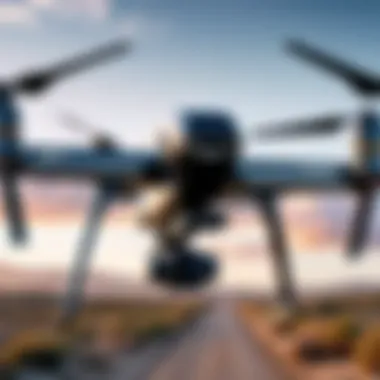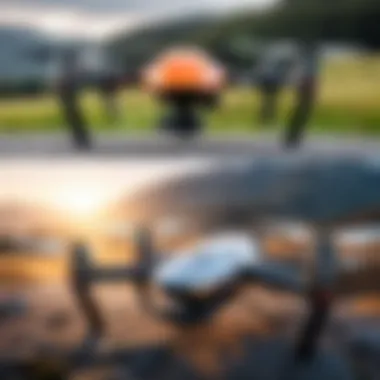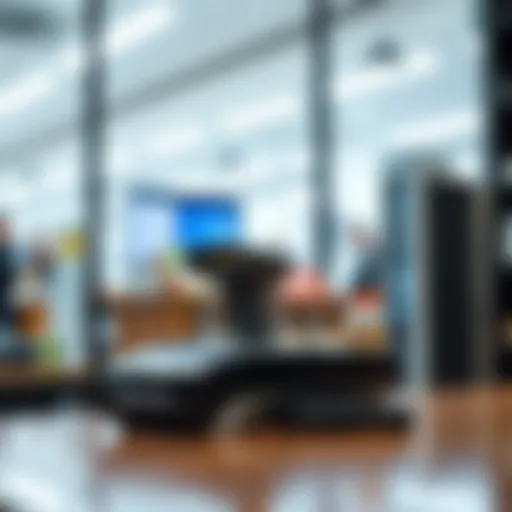Choosing Drones with High-Quality Cameras for Photography


Intro
As the realm of photography expands to the skies, drones have emerged as essential tools for capturing breathtaking imagery. With a plethora of models available, selecting the right drone equipped with a high-quality camera can seem daunting. This process involves not just aesthetics, but also technical specifications, user experience, and practical applications.
Drones designed for photography come with a diverse range of features—from resolution and stabilization to software compatibility. Whether one is a budding enthusiast wanting to elevate their Instagram game or a seasoned pro looking for the next big thing, understanding these elements is key.
Every potential user must weigh their options carefully. What difference does a 4K camera make when compared to one that captures in 1080p? How significant are flight time and user interface in achieving desired photography outcomes? This article aims to explore these pivotal questions, offering genuine insights for tech-savvy users—especially Android enthusiasts—who wish to choose wisely.
Moreover, the credibility of manufacturers plays a crucial role. A reputable brand doesn't just guarantee quality; it also assures users of reliable customer support and valuable community engagement. Whether for personal enjoyment or professional intentions, the right drone can transform one's photographic approach, turning breathtaking landscapes into stunning visuals.
In the following sections, we will delve deeper into what constitutes an ideal photography drone, equipping readers with the knowledge needed to make an informed choice.
Intro to Drones with Superior Cameras
Drones are not just flying gadgets; they represent a significant leap in technology that opens up a world of possibilities for photographers and videographers. When it comes to capturing stunning aerial imagery, drones equipped with superior cameras are game changers. The main reason for this is simple: the quality of the camera can drastically influence the overall outcome of both still images and videos.
Imagine a landscape shot taken from hundreds of feet above, displaying a breathtaking blend of colors and textures. This is the power harnessed through advanced camera systems integrated into drones. A good camera in a drone is not merely about having many megapixels; it’s about how those pixels translate into depth, clarity, and vibrant hues. It’s a workhorse that allows you to capture images that tell stories and evoke emotions—all from the sky.
Defining a Good Camera in Drones
The term 'good camera' often varies depending on the user's needs, but certain criteria stand out. Key factors include resolution, sensor quality, lens capability, and adaptability in different lighting conditions. Let’s unpack these a little:
- Resolution Matters: More megapixels can mean greater detail. That said, a high-resolution image does little good if the camera’s other features lag behind. A 50 MP image might fall flat if it’s captured in poor lighting.
- Sensor Quality: Larger sensors typically capture more light, which is paramount for aerial photography where conditions can change without notice. CMOS vs. CCD—what's the hype? CMOS sensors are more common in drone cameras today for their efficiency and speed.
- Lens Capability: Different lenses can manipulate focal lengths and aperture settings. This flexibility allows the photographer to adjust the framing and exposure based on the scene.
While the specifications paint a decent picture, the practical experience of using those cameras—whether in bright sunlight or nearing dusk—can be far more telling.
The Role of Camera Technology in Drone Performance
Camera technology fundamentally influences a drone’s performance. It's not just about flying high; it’s about capturing high-fidelity images as well. Modern drones utilize a variety of camera advancements:
- Image Stabilization: This technology reduces shake caused by drone movements—essential for smooth video and crisp photos. Drones may employ gimbals or electronic stabilization measures, each with its strengths.
- Low-Light Performance: Quality camera tech also means better adaptability in varying light conditions. Drones that boast exceptional low-light performance can capture night scenes or early dawn with remarkable clarity.
- Real-time Feedback: Many advanced drones provide live video feed capabilities, allowing users to adjust settings or framing in real time. This is critical for getting that perfect shot.
In essence, a drone equipped with top-notch camera technology can significantly enrich the photographic experience. Whether for passion or profession, understanding these components serves as a stepping stone towards making informed choices in the ever-evolving field of drone photography.
Camera Specifications to Consider
When it comes to selecting a drone, camera specifications play a pivotal role in determining both the quality of captured images and the overall performance of the device. For enthusiasts and professionals alike, diving into the specifics can make the difference between a lackluster aerial snapshot and a breathtaking landscape photograph. The sophistication of camera technology in drones reflects a delicate balance of megapixels, sensor size, and lens quality. Each element not only affects image sharpness and clarity but also dictates how versatile a drone can be during different types of photography.
The importance of understanding these specifications cannot be overstated. A drone with a superior camera can elevate your photography by offering sharper images, better low-light performance, and a wider range of creative possibilities, enhancing the user’s experience significantly. Let's explore some of the key specifications to consider when choosing a drone for aerial photography.
Megapixels and Image Quality
The term 'megapixel' often gets tossed around in discussions about camera quality, but what does it really mean for drone photography? Simply put, megapixels indicate the amount of detail an image can hold. The higher the megapixel count, the larger the image can be printed without losing clarity. For those who like to shoot vast landscapes or vibrant cityscapes, a drone boasting at least 12 megapixels is generally preferable. However, it's important to note that a high megapixel count doesn't automatically translate to great image quality.
Other factors, such as the quality of the lens and sensor type, come into play. A drone with 20 megapixels could produce inferior images if it lacks an effective sensor or lens. Therefore, it’s crucial to consider not just the number, but also how it performs in various conditions. For instance, how well does the camera fare in low light? Does the color reproduction match the vibrancy of what the human eye sees? Questions like these are essential while shortlisting drones for photography.


Sensor Size and Type
The sensor is the heart of any camera, including those mounted on drones. A larger sensor generally captures more light and detail, translating into clearer images with reduced noise, especially in tricky lighting situations. Most drones come with either CMOS (Complementary Metal-Oxide-Semiconductor) or CCD (Charge-Coupled Device) sensors. CMOS sensors tend to be more prevalent in drones due to their ability to produce high-quality images while consuming less power, which is crucial for extending flight time.
When considering size, options such as 1-inch sensors or larger are becoming increasingly common. These offer superior dynamic range and better performance in low-light scenarios. You might find mid-range drones featuring slightly smaller sensors, which could still work well for casual outdoor photography, but the ambitions should guide your choice. If you aim to crank it up for professional use, then investing in a drone with a larger sensor is non-negotiable.
Lens Quality and Field of View
The lens is arguably what colors the final image perception, and its quality can often outshine the sensor or megapixel count. A high-quality lens will minimize distortion and allow for sharper images around the edges, which is vital for capturing landscapes. Not to mention, field of view (FOV) is integral in determining how much of the scene your camera can take in. A wider FOV lets you get more of your surroundings into one shot, which is particularly useful in landscape and architectural photography.
Typically, drone lenses range from 24mm to 35mm equivalents. Wider lenses, commonly found in consumer drones, allow for more expansive views but may introduce distortion if not well designed. A good rule of thumb is opting for lenses exhibiting a sharp corner performance. It’s worth checking user reviews or video demonstrations before settling on a model; after all, seeing what others capture with a particular lens can reveal a lot about its capabilities.
Ultimately, understanding the nuances of these camera specifications can empower you to make an informed choice when selecting a drone. If you're looking to capture the world from a stunning angle, don't just go for the glamor of high numbers or brands. Dig deeper, and consider how those specifications align with your photography aspirations.
Essential Features for Aerial Photography
When diving into the realm of drones for photography, understanding essential features becomes paramount. The right blend of technology and user-friendliness can elevate your aerial shots from mundane to mesmerizing. These features not only enhance the quality of photos but also broaden the scenarios in which a drone can be effectively used.
Stabilization Technologies
Gimbals
Gimbals play a crucial role in maintaining the stability of drone-mounted cameras. They help counteract the movements and vibrations of the drone, ensuring that the camera remains level. This results in smoother video shots and sharper photos, which is essential for professional-grade photography. The key characteristic of gimbals is their ability to pivot on multiple axes, which is often referred to as stabilization in three dimensions.
One standout trait of gimbals is their versatility. They are adaptable to different camera sizes and weights, allowing you to swap out equipment without skipping a beat. While they are generally considered a beneficial addition, they can add weight to the drone, which may affect flight time. However, for serious photographers, the enhanced image quality they provide justifies any slight increase in payload.
Electronic Stabilization
On the flip side, there's electronic stabilization, which utilizes software algorithms to reduce motion blur. Unlike mechanical gimbals, electronic alternatives do not require extra hardware, making them lighter and sometimes more efficient. The key defining edge is their seamless integration into existing camera systems, minimizing setup complexity for users.
What makes electronic stabilization appealing is its ability to correct small jerks caused by wind or sudden movements during flight. Though it offers decent stabilization, it may not always match the effectiveness of a good gimbal in terms of producing ultra-smooth footage. Photographers need to weigh the trade-off between weight and stability based on their specific aerial photography needs.
Real-time Video Transmission
Real-time video transmission is another essential feature for aerial photography. This capability allows the pilot and the photographer to see exactly what the camera is capturing in real-time. It leads to better framing of shots and makes it easier to track moving subjects. For those who want to capture dynamic scenes, like surfers riding waves or wildlife in action, this feature can significantly improve the workflow.
When evaluating drones for this feature, pay attention to the lag time in transmission. Some lower-end models can exhibit latency issues that could lead to missed shots. A drone that offers low-latency transmission not only improves the shooting experience but also boosts the photographer's confidence in achieving desired angles.
Intelligent Flight Modes
Follow Me Mode
Follow Me Mode is a game-changer for solo photographers and vloggers. As the name suggests, this feature allows the drone to autonomously follow and record a moving subject. The primary benefit here is the freedom it grants to the photographer, allowing them to focus solely on their activity without worrying about manually piloting the drone. The drone's GPS and visual recognition technology work together to ensure a consistent viewpoint.
One of the standout traits of Follow Me Mode is its adaptability. Photographers can engage in various activities—like biking or hiking—and capture stunning footage as they go. However, it’s important to ensure that the surroundings are suitable for flying; obstacles can confuse the drone's sensors, leading to abrupt stops or erratic movements.
Waypoint Navigation


Waypoint Navigation offers a more planned approach to aerial photography. Users can set predefined points for the drone to fly to, capturing photos and videos at each stop. This feature allows for meticulous planning, ensuring that each shot is precisely where you want it, and can be especially useful for time lapses or surveying large areas.
Waypoint navigation is beneficial for ensuring consistency in shots, particularly in professional environments like real estate or landscape photography. However, it comes with its own set of challenges, like the necessity of an open line-of-sight and reliable GPS. Users must be keenly aware of their surroundings and drone capabilities while planning these automated paths.
In summary, understanding these essential features can significantly enhance your aerial photography experience. Whether you prioritize stabilization technologies, real-time transmission, or intelligent flight modes, each aspect contributes to the overall quality and effectiveness of your drone shooting.
Building a Quality Drone Portfolio
When it comes to aerial photography, the drone you choose plays a significant role in capturing breathtaking shots. Building a quality drone portfolio is more than just owning a fancy gadget; it’s about curating a selection of drones that align with your photography needs and expertise.
Entry-Level Drones with Good Cameras
For those just stepping into the world of drone photography, entry-level drones with competent cameras offer an excellent starting point. These models are generally user-friendly and come equipped with features that facilitate learning the ropes without overwhelming the beginner. Brands like DJI offer options such as the Mavic Mini, which boasts a sturdy camera for its size, allowing users to take 2.7K video and 12MP photos.
These drones often feature a simplified control system, making it easier to focus on mastering the art of flying. Additionally, they are usually compact and lightweight, making them convenient to transport. Not to mention, their price point is usually gentler on the wallet, allowing beginners to experiment without committing a fortune upfront.
Professional Drones for Advanced Photography
On the flip side, professional drones cater to seasoned photographers demanding high-quality imagery and advanced capabilities. These drones, such as the DJI Phantom 4 Pro or the Autel Robotics EVO Lite, come fitted with larger sensors, improved lenses, and greater stabilization techniques. When these features are combined, they provide exceptional clarity and detail under varying conditions.
Furthermore, their higher-cost stimulants often include advanced flight modes, like Waypoint Navigation, that allow you to predetermine a flight path. This can be crucial when trying to capture a shot that requires precision, like a landscape or a moving subject. Investing in a professional drone not only enhances your portfolio but also elevates your overall photography game.
Comparative Analysis of Popular Models
When it comes down to which drone to choose, it's beneficial to conduct a comparative analysis of popular models. Not only should you consider the specifications but also real-world use cases. Here’s a quick breakdown:
- Camera Capability: Compare resolutions, sensor sizes, and lens quality across models. Higher megapixels and larger sensors typically result in better low-light performance.
- Battery Life: Look for drones that can stay airborne longer — typically more than 20 minutes of flight time is desirable for serious photography.
- Flight Stability: Assess stability control technologies, such as gimbals and GPS alignment, which are crucial for obtaining steady shots.
- User Support and Community Feedback: Platforms like reddit.com host discussions where users share their experiences. These insights are invaluable when making a choice.
A careful blend of these parameters can help in identifying which drone meets your specific photography aspirations the best. Remember, the right drone not only improves your portfolio but also enhances your creative expression in the skies.
User Experience and Community Feedback
When selecting a drone equipped with a high-quality camera, it’s crucial not to overlook the real-world experiences of users. Feedback from the community can shed light on both the strengths and weaknesses of various drone models. This section dives into the importance of user experiences and community feedback, both of which can serve as guiding lights for potential buyers navigating through the multitude of choices.
Importance of User Reviews in Choosing Drones
User reviews bring invaluable insights to the table. They reflect not only the technical aspects of the drones but also practical elements that specifications might not cover. For instance, a drone that boasts impressive specifications on paper may fall short when it comes to actual ease of use or reliability in various weather conditions.
- Real-world performance: Many reviews discuss how drones perform under actual flying conditions. Things like battery life, stability during flight, and responsiveness can be different than you might think based on manufacturer claims.
- Camera quality: While specs indicate megapixels and sensor sizes, user feedback often reveals the nuances of image quality when used in diverse environments. Witnessing photos taken by actual users can provide a clearer picture than any marketing blurb.
- Durability: Heard of drones that didn’t survive the first crash? Reviews can highlight whether a drone can withstand the rigors of outdoor use, which is vital for those who fly in demanding terrains.
Ultimately, diving into reviews can help buyers avoid pitfalls and choose drones that truly meet their needs. As they say, "don’t judge a book by its cover," the same goes for tech gadgets like drones. Community voices can provide clarity in what otherwise might be a muddy waters of technical jargon.
Community Platforms for Drone Enthusiasts
In this digital age, various platforms host vibrant communities filled with drone enthusiasts. These spaces allow for sharing experiences, offering solutions, and discussing equipment. Engaging in these communities can be a game changer for both novice and seasoned drone pilots.
- Reddit: Subreddits dedicated to drones see active discussions, reviews, and tips. Here, users share their hands-on experiences, whether it's about fixing common issues or showcasing stunning aerial shots. It’s like a treasure trove of real-time insights. You might even find users discussing their favorite camera brands or flight technologies.
- Facebook groups: Many drone-specific Facebook groups foster communities where enthusiasts can connect, share and learn. In these groups, you can easily find a range of opinions and personalized advice, which might resonate better than general reviews.
- YouTube: Many channels focus on drone tech. Visual demonstrations show how drones perform in real life. And sometimes, seeing is believing when it comes to understanding image quality and stabilization features.


Engaging with these platforms serves not just as a learning tool but also as a way to stay updated on trends, technology advancements, and user-favored products. The wealth of knowledge on these community platforms enriches one’s understanding of current drones and can significantly influence purchase decisions.
"When it comes to drones with superior cameras, community feedback can often unveil the real deal that specifications miss."
In summary, examining user experiences and tapping into community feedback provide layers of understanding and context that can significantly impact the drone selection process. Whether one is a beginner or an experienced flyer, leveraging community insights can lead to wiser purchase decisions and ultimately richer aerial photography experiences.
The Future of Drones and Camera Integration
Drones have become a staple in photography and videography, revolutionizing the way we capture images. But what's next on the horizon? Understanding the future of drones and camera integration is pivotal for anyone looking to invest in this technology. This section looks closely at emerging developments that aim to enhance aerial photography experience while making technology more accessible.
Emerging Technologies in Drone Cameras
Innovation in drone cameras is like a wildfire that refuses to be contained. Manufacturers are racing to roll out enhanced features that can completely change the game. High-resolution sensors are now just the tip of the iceberg. New technologies like LiDAR, for instance, are catching attention, offering precise measurements and detailed mapping capabilities.
Moreover, computational photography is gaining ground. This involves using algorithms to improve image quality. Think of it as having a mini photo lab inside your drone. Incorporating this tech allows for better low-light performance and dynamic range, turning even hazy sunsets into gorgeous vistas.
Also, we cannot overlook advancements in camera stabilization. Gyroscopic technology is getting even sharper, ensuring that your aerial shots are as steady as a rock. Less shaking translates into cleaner, crisper images, elevating the standard of what aerial photographers can produce.
Predictions for Changes in Drone Usage
The landscape of drone usage is poised for change like the wind on a blustery day. As technology becomes more sophisticated, we can expect new trends to emerge. A key trend is the increased adoption of drones in sectors outside photography, such as agriculture and disaster management. Imagine drones equipped with thermal imaging cameras identifying hotspots in forest fires or tailored imaging solutions surveying crops for health.
This crossover into various fields could raise ethical considerations around surveillance and privacy. As drones are used more in public spaces, regulations may tighten, leading to more robust frameworks governing their usage.
Collaboration between drone manufacturers and software developers will spur new capabilities. For example, integrating AI with camera functionalities could automate various processes. Automating focus and tracking will allow photographers to capture shots that would be difficult for a human to achieve, like subjects moving at high speed.
Although we’ve come a long way, it's clear that we stand at the junction of widespread drone technology adoption. The integration of cameras with these devices will continue pushing the boundaries of what is possible in aerial photography and beyond.
"The future of drones is not just about flying, is about transforming perspectives and experiences through advanced camera tech.”
Culmination and Recommendations
When considering the vast possibilities drones with superior cameras bring to the world of photography, it becomes paramount to grasp a balance between technical specifications and practical usage. This article aims to equip tech-savvy individuals and Android users with a clear understanding of how to assess and choose the right drone.
The right drone not only enhances aerial photography but also elevates your entire shooting experience. Several factors interplay in this selection, such as image quality, stabilization features, and user-friendly controls. Knowing what to prioritize can drastically affect the outcome of your photography endeavors.
"The best camera is the one you have with you."
- Chase Jarvis
As we wrap up, let’s summarize the essential points discussed, shedding light on why these are critical in making an informed choice.
Summarizing Key Points
- Camera Evolution: Drones equipped with advanced cameras can significantly improve how we capture the world from above. The technological advancements in this field have rendered previous limitations obsolete.
- Specification Essentials: Megapixels, sensor size, and lens quality are fundamental aspects to evaluate when searching for a drone. Each feature contributes uniquely to the image output.
- User Experience: Feedback from existing users lays the ground for selecting reliable models, highlighting real-world performance over marketing claims.
- Safety and Regulation: Understanding local drone laws and safety measures helps in having a hassle-free flying experience.
Understanding and keeping these points top-of-mind boosts not only technical selection but also aligns your expectations with practicality.
Guidelines for Selecting the Right Drone
- Define Your Purpose: Be clear about what you want to achieve. Are you planning to document weddings, explore nature, or create commercial content? Each use case dictates different specifications.
- Set a Budget: Balancing quality with budget limitations is necessary. Drones can vary significantly in price, so it’s vital to find one that offers the best value for the money.
- Research and Reviews: Dive into user reviews and community feedback. Platforms such as Reddit and specialized forums can provide invaluable insights that brands seldom mention.
- Test Flight: If possible, always try before you buy. Many shops or brands offer demo units; feeling how a drone handles in the air can inform your decision immensely.
- Regulatory Compliance: Ensure the model you pick adheres to local regulations regarding drone usage. Safety should be an utmost priority to avoid legal issues that could tarnish your photography ambitions.
With these guidelines in hand, you'll be well-armed to make a strategic choice that enhances your photographic journey, ensuring that your investment pays off in both quality and creativity.







